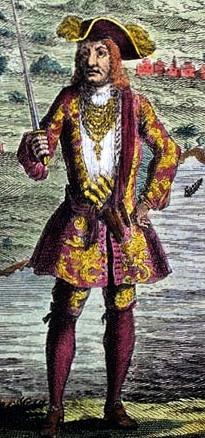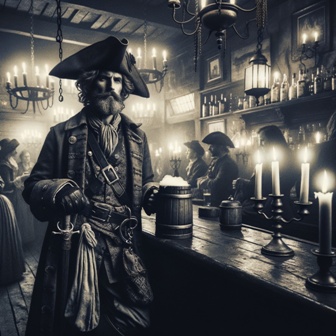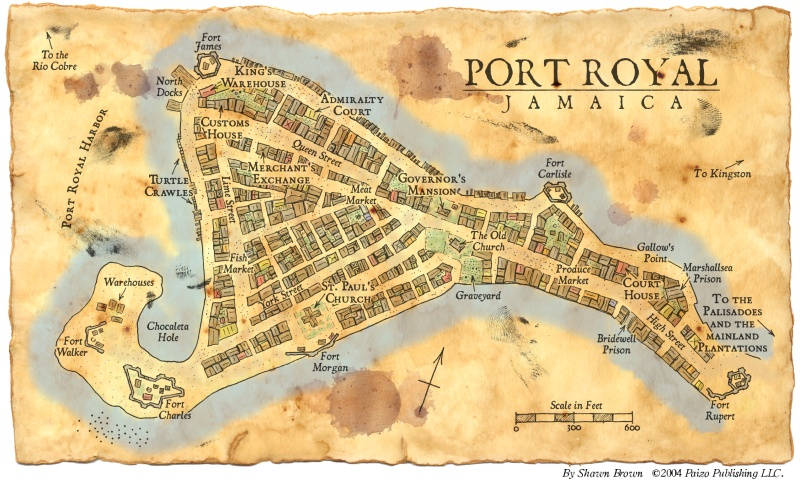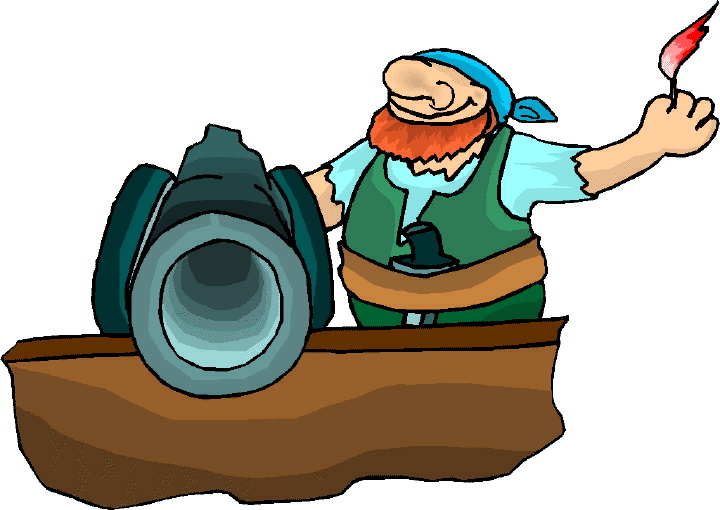 Pirates and Privateers Pirates and Privateers
The History of Maritime
Piracy
Cindy Vallar, Editor
& Reviewer
P.O. Box 425,
Keller, TX 76244-0425
    
In Memoriam
Articles & Taverns
One of
Blackbeard’s most threatening moves was his blockade
of Charles Town in 1718. It seemed an unlikely time
for drink to be involved; nevertheless, it was and
it almost resulted in the destruction of the South
Carolinian port.
Governor
Robert Johnson wrote to the Council of Trade
and Plantations:
. . .
about 14 days ago 4 sail of [pirates] appeared
in sight of the Town tooke our pilot boat and
after wards 8 or 9 sail wth. severall of the
best inhabitants of this place on board and then
sent me word if I did not imediately send them a
chest of medicins they would put every prisoner
to death which for there sakes being complied
with after plundering them of all they had were
sent ashore almost naked. (America, June
18. 556.)
 What Johnson omitted
from this account was that the messenger who
delivered the ransom demand had been escorted ashore
by two pirates, who promptly disappeared. The
governor and his advisors set about assembling the
medicine chest, but when they were ready to deliver
it, the pirate escorts couldn’t be found. “A general
alarm was given, and a search was made for the
missing pirates. They were finally discovered,
smiling and gloriously drunk.” (Lee, 47) Upon their
arrival in town, they strode about the streets as if
they had nothing to fear. (In truth, no one was
going to accost them while Blackbeard held the
citizenry at bay.) That’s when they met some
drinking buddies of yore, and they immediately
retired to a tavern to hoist a few and bring each
other up to date. What Johnson omitted
from this account was that the messenger who
delivered the ransom demand had been escorted ashore
by two pirates, who promptly disappeared. The
governor and his advisors set about assembling the
medicine chest, but when they were ready to deliver
it, the pirate escorts couldn’t be found. “A general
alarm was given, and a search was made for the
missing pirates. They were finally discovered,
smiling and gloriously drunk.” (Lee, 47) Upon their
arrival in town, they strode about the streets as if
they had nothing to fear. (In truth, no one was
going to accost them while Blackbeard held the
citizenry at bay.) That’s when they met some
drinking buddies of yore, and they immediately
retired to a tavern to hoist a few and bring each
other up to date.
Such overindulgence was to be expected, but the
delay could have resulted in one domino knocking
over another and another and another. And
Blackbeard’s ire would have had devastating effect
on the pirate victims, Charles Town, and the pirate
escorts had the medicine chest failed to arrive.
Cooler heads prevailed this time, but other pirate
captains wrote safeguards into their articles so
that intemperance didn’t result in dire
consequences.
For example, the 23 August 1723 edition of The
Boston News-Letter printed the Articles of
Agreement under which Edward Low and his men sailed.
(This code had been seized after HMS Greyhound captured
Charles
Harris and other pirates who had been sailing
in consort with Low at the time of the attack.
Twenty-six, including Harris, would hang in Newport,
Rhode Island.) One article concerned being soused.
VI. He
that shall be Guilty of Drunkenness in the Time
of an Engagement, shall suffer what Punishment
the Captain and the majority of the Company
shall think fit. (Tryals of Thirty-six, 3:
191)
Francis
Spriggs, another of Low’s cohorts, captured a
man named Richard Hawkins, who wrote of his
captivity for The British Journal in August
1724. One interesting tidbit pertained to the
company’s handling of those who imbibed overmuch.
In the
Morning they enquire who was drunk the last
Night, and whosoever is voted so, must either be
at the Mast-Head four Hours or receive a
Ten-handed Gopty, (or ten Blows in the Britch)
from the whole Watch. I observ’d it generally
fell on one or two particular Men; for were all
to go aloft that were fuddled over Night, there
would be but few left to look out below. They
seldom let the Man at the Mast-Head cool upon
it, but order him to let down a Rope to hawl up
some hot Punch, which is a Liquor every Man
drinks early in the Morning. They live very
merrily all Day; at Meals the Quarter-Master
overlooks the Cook, to see the Provisions
equally distributed to each Mess; whether they
were drunk or sober, I never heard them drink
any other Health than King George’s. (Pirates,
301)
 Although Bartholomew
Roberts preferred tea to alcohol, he
understood the chances of swaying his men to his
preferences weren’t high. The first article in his
code of conduct was “Every Man . . . has equal title
to the fresh Provisions, or strong Liquors, at any
Time seized, and use them at Pleasure . . . .”
(Johnson, 169) The fourth article added one
stipulation to those who would drink after eight in
the evening; they could only do so on the weather
deck. Although Bartholomew
Roberts preferred tea to alcohol, he
understood the chances of swaying his men to his
preferences weren’t high. The first article in his
code of conduct was “Every Man . . . has equal title
to the fresh Provisions, or strong Liquors, at any
Time seized, and use them at Pleasure . . . .”
(Johnson, 169) The fourth article added one
stipulation to those who would drink after eight in
the evening; they could only do so on the weather
deck.
Ashore, in havens friendly to roguish clientele, the
pirates frequented taverns. Nearly every colonial
village, town, and city had at least one where
locals and visitors gathered to eat, drink, and
talk. Captain Thomas Walduck wrote the following to
John Searle, his nephew, in 1708.
Upon all
the new settlements the Spaniards make, the
first thing they do is build a church, the first
thing the Dutch do upon a new colony is build
them a fort, but the first thing ye English do,
be it in the most remote part of ye world, or
amongst the most barbarous Indians, is to set up
a tavern or drinking house. (Codfield)
Pietro
Aretino, an Italian satirist who lived from
1492 to 1556, wrote this about drinking
establishments.
He who
has not been at a tavern knows not what a
paradise it is. O holy tavern! O miraculous
tavern! – holy, because no carking cares are
there, nor weariness, nor pain; and miraculous,
because of the spits, which turn themselves
round and round!
Little wonder that
pirates and locals sought respite there.
Taverns,
originally known as ordinaries, were places where
drinks and meals were served. (If you wanted a room,
that required an inn.) Punch-houses served a
particular mixed drink, usually to lower-class
clientele. (Its secondary meaning, brothel, came
later.) Such places allowed locals to catch up on
news and gossip, or entertain themselves with
gambling or playing cards. The proprietors might be
men or women. On the odd chance that a pirate might
expect a letter, these ordinaries sometimes served
as post offices. They were also places where pirate
captains, merchant captains, and military recruiters
sought new blood.
 Marcus
Hook in William Penn’s colony of Pennsylvania
welcomed pirates, including Blackbeard. “Marcus Hook
was the first port of call for Philadelphia from its
earliest days, and later would become the farthest
upriver that large ships could safely navigate”
without a pilot familiar with the tides, navigable
waterways, and unseen dangers of the Delaware River.
(Plank) Marcus
Hook in William Penn’s colony of Pennsylvania
welcomed pirates, including Blackbeard. “Marcus Hook
was the first port of call for Philadelphia from its
earliest days, and later would become the farthest
upriver that large ships could safely navigate”
without a pilot familiar with the tides, navigable
waterways, and unseen dangers of the Delaware River.
(Plank)
If tradition be accepted as authority, at the
conclusion of the seventeenth and the first and
second decades of the eighteenth century the pirates
which then infested the Atlantic coast from New
England to Georgia would frequently stop at Marcus
Hook, where they would revel, and when deep in their
cups would indulge in noisy disputation and broils,
until one of the streets in that ancient borough
from that fact was known as Discord Lane, which name
the same thoroughfare has retained for nearly two
centuries. (Ashmead, 457)
Most taverns
in colonial times were simple in design.
The
earliest taverns were mostly independent
structures, yet they could also be located
within or attached to residential houses. The
interiors . . . were designed with different
rooms, the largest room being the taproom with
furnishings such as chairs, desks, the bar, and
a fireplace. (Streczinki, 30)
Outside the tavern, a sign
denoted the establishment’s name in both words and
pictures. Extant deeds prior to 1692, identified
nineteen taverns that buccaneers might have visited
in Port Royal,
Jamaica.
Tavern Name
|
Date
|
Location
|
The Three Tunns
|
1665
|
east side of private alley
across from Wherry Bridge
|
The Sugar Loaf
|
1667
|
location unknown
|
The Sign of Bacchus
|
1673
|
Yorke Street
|
The Three Crownes
|
1673
|
corner of High Street and Lime
|
The Green Dragon
|
1674
|
Smith’s Alley and Queen Street
|
The Shipp
|
1674
|
Queen Street
|
The Catt and Fiddle
|
1676
|
Thames Street
|
The Jamaica Arms
|
1677
|
Yorke Street
|
The Three Mariners
|
1677
|
west side of Honey Lane
|
| The Blue Anchor |
1679 |
location unknown |
| The Salutaçon |
1680 |
middle plot between Honey Lane
and the King’s house |
| The Feathers |
1681 |
off Thames street on west side
of private alley |
| The Black Dogg |
1682 |
location unknown |
| The Sign of the George |
1682 |
facing old market place |
| The Cheshire Cheese |
1684 |
New Street |
| The Windmill |
1684 |
Cannon Street |
| The Sign of the Mermaid |
1685 |
across from Wherry Bridge at
end of private alley |

Two taverns bore the name
“The King’s Arms.” The first opened in 1677, and
faced the parade ground. The second opened five
years later.
The Feathers was “newly-built with brick” on the
site of a tavern which had the same name. The
proprietors, Thomas and Ann Mills, ran “a large shop
with a large entry with a large balcony room over
them and another room or bed-chamber and a cellar.”
The yard held “an arbour and house of office, a
cookroom of brick next to it, a large lower room
with a partition, and a billiard-room over that,
with a larger pair of stairs going up to it.”
(Pawson, 114)
When Thomas Freeman purchased The Three Tunns from
Charles Whitfield in December 1695, the tavern had
already been serving patrons for some time. It was
located close to The Feathers.
Captain Charles Penhallow of the Port Royal militia
and a warden in his church, owned The Three
Mariners, which he probably bought from Peter
Bartaboa and John Grandmaison, both of whom were
French. The former’s main occupation was carpentry,
and he built Port Royal’s gallows for £3 in 1666.
Nearby was The Salutaçon, which Randolph Bolton ran
for a long time. Jacob Haynes owned the plot of land
on which William Hanson, the city’s blacksmith,
operated The Green Dragon as a tavern and inn.
John Hay, a victualler and merchant, built The Catt
and Fiddle and ran the tavern with his wife
Susannah. Twenty years later, Hay sold the it to
carpenter Moses Watkins for a sum of £800.
It was common for taverns to have different rooms,
and each of these was known by its own name. One
example came from an unnamed tavern owned by Thomas
Taylor. Upon his death in 1674, an inventory was
made of his property.
In a roome
called the Vinroome
A great
wooden chest, a signe, a stripe carpet and an
old saddle
In the Queen’s Head
An old
planeen [sic] bed, a cedar bedstead and three
old leather trunks, a green rugg, a pillow and
bolster
Two diaper
table-clothes and seaven napkins
In the bar room
Two
punch bowles, two earthen potts and a silver
dram cup
In the Nag’s Head
A
tobacco knife, a copper pott, two spitts, a
table and two formes, a wooden pestle and
morer, two old gunns.
In the sellar
About
20 gallons of Madera at 3s. per gallon
About 18 gallons
of brandy at five shillings and sixpence per
gallon
About a hogshead
of sower clarett
A payr of
carriers and eight pounds of candles
In the Rose
An old
truncke with severall old clothes with a set
of green curtins; a table and two forms
In the King’s Head
Six
joynt stooles, elleavon red leather chaires
A fuzends [sic]
and old chest, fower hamockers
A man servant,
about elleavon months to serve
A brasse kettle
and skillet, a small brasse pan, a frying-pan
and a paire of andirons, a lattin dripping-pan
and an ax
Seventy-five
pounds of pewter, being five dishes, sixteen
plates, two salt-sellers, three basons, one
porringer, one sawcer
Two old
chamber-potts, a pottle pott, two pint potts,
two gill potts, a quart pott and a half-pin
pott (Pawson, 147-148)
Although cash was always
welcome, in the colonies it wasn’t always available.
The primary form of currency on St. Christopher’s
(St. Kitts) when the buccaneers preyed in the
Caribbean was sugar. In September 1678, the island’s
assembly passed four acts, one of which concerned
taverns: “An Act touching tavern keepers and rum
punch house keepers not to trust any person upon
account for above 200 lbs. of sugar before taking a
note (sic) for the same.” (America.
March-Sept. 1678, #645.) This prevented drunken
pirates from running up high tabs, unless they
provided some form of written IOU.
Rowdiness was more the norm when it concerned
pirates with money in their pockets. Jonathan Swift,
the Irish satirist who wrote Gulliver’s Travels
(1726), once wrote that “A tavern is a place where
madness is sold by the bottle.” That might be where
the pirates procured their drink, but it wasn’t
always where they drank. Alexandre Exquemelin’s
master
often used to buy a butt of wine and set it in
the middle of the street with the barrel-head
knocked in, and stand barring the way. Every
passer-by had to drink with him, or he’d have
shot them dead with a gun he kept handy. Once he
bought a cask of butter and threw the stuff at
everyone who came by, bedaubing their clothes or
their head, wherever he could reach.
(Exquemelin, 82)
 Roche
Brasiliano had a violent streak, which
drunkenness seemed to accentuate. Roche
Brasiliano had a violent streak, which
drunkenness seemed to accentuate.
He had
no self-control at all, but behaved as if
possessed by a sullen fury. When he was drunk,
he would roam the town like a madman. The first
person he came across, he would chop off his arm
or leg, without anyone daring to intervene, for
he was like a maniac. (Exquemelin, 80)
Exquemelin also mentioned that “tavern-keepers let
them have a good deal of credit,” but he warned his
readers not to trust those in Jamaica. If you racked
up too much debt, the tavern keeper could sell you
to gain back his money. “Even the man . . . who gave
the whore so much money to see her naked, and at
that time had a good 3,000 pieces of eight – three
months later he was sold for his debts, by a man in
whose house he had spent most of his money.”
(Exquemelin, 82)
. . . To be continued
Resources:
“America
and West Indies: March 1678,’ in Calendar
of State Papers Colonial, America and West
Indies: Volume 10,1677-1680 edited by W.
Noel Sainsbury and J. W. Fortescue. London, 1896,
220-231 (March-Sept. St. Christopher’s. 645.)
“America
and West Indies: August 1698, 22-25,’ in Calendar
of State Papers Colonial, America and West
Indies: Volume 16,1697-1698 edited by J. W.
Fortescue. London, 1905, 399-406 (Aug. 25. 771.).
“America
and West Indies: June 1718,” in Calendar of
State Papers Colonial, America and West Indies:
Volume 30, 1717-1718 edited by Cecil Headlam.
London, 1930, 264-287. (June 18. Charles Towne,
South Carolina. 556.).
Andrade, Tonio.
Lost Colony: The Untold Story of China’s First
Great Victory Over the West. Princeton,
2011.
Antony, Robert J. Like
Froth Floating on the Sea: The World of Pirates
and Seafarers in Late Imperial China.
Institute of East Asian Studies, University of
California Berkley, 2003.
Appleby, John C. Women
and English Piracy 1540-1720: Partners and
Victims of Crime. Boydell, 2013.
Ashmead, Henry Graham.
History
of Delaware County, Pennsylvania. L.
H. Everts & Co., 1884.
Bahadur, Jay. The Pirates of Somalia: Inside
Their Hidden World. Pantheon Books, 2011.
Bialuschewski, Arne. Raiders
and Natives: Cross-cultural Relations in the Age
of Buccaneers. University of Georgia, 2022.
Bold in Her
Breeches: Women Prostitutes Across the Ages
edited by Jo Stanley. Pandora, 1996.
Borvo, Alain. “Discover
Aluette, the Game of the Cow,” Traditional
Tarot (21 July 2021).
Bradley, Peter T. Pirates
on the Coasts of Peru 1598-1701.
Independently published, 2008.
Brooks, Baylus C. Quest
for Blackbeard: The True Story of Edward Thache
and His World. Independently published,
2016.
Brown, Edward. A
Seaman’s Narrative of the Adventures During a
Captivity Among Chinese Pirates, on the Coast
of Cochin-China. Charles Westerton,
1861.
Burg, B. R. “The
Buccaneer Community” in Bandits at Sea: A
Pirates Reader edited by C. R. Pennell. New
York University, 2001, 211-243.
Choundas, George. The Pirate Primer: Mastering
the Language of Swashbucklers and Rogues.
Writer’s Digest, 2007.
Codfield, Rod. “Tavern
Tales: 1708 Letter,” Historic London
Town & Gardens (2 April 2020).
Cotton, Charles. The
Compleat Gamester. London: Charles Brome,
1710.
Croce, Pat. The
Pirate Handbook. Chronicle Books, 2011.
Dampier, William. A New
Voyage Round the World vol. 1. London:
James Knapton, 1699.
Defoe, Daniel. A
General History of the Pyrates edited by
Manuel Schonhorn. Dover, 1999.
Duffus, Kevin P. The
Last Days of Black Beard the Pirate. Looking
Glass Productions, 2008.
Eastman, Tamara J., and Constance Bond. The
Pirate Trial of Anne Bonny and Mary Read.
Fern Canyon Press, 2000.
Ellms, Charles. The
Pirates Own Book. 1837.
Esquemeling, John. The Buccaneers of America.
Rio Grande Press, 1684.
Exquemelin, Alexander
O. The Buccaneers of America translated by
Alexis Brown. Dover, 1969.
“FAQs:
Beverages,” Food Timeline edited by
Lynne Olver (30 November 2021).
Ford, Michael. “The
Attack of the ‘Last Great Pirate’ – Benito De
Soto, Wellington’s Treasure and the Raid of the
‘Morning Star,’ Military History Now
(21 June 2020).
Ford, Michael E. A. Hunting
the Last Great Pirate: Benito de Soto and the
Rape of the Morning Star. Pen & Sword,
2020.
A Full
and Exact Account of the Tryal of the Pyrates
Lately Taken by Captain Ogle. London:
J. Roberts, 1723.
Further
State of the Ladrones on the Coast of China.
Lane, Darling, and Co., 1812.
Geanacopulos, Daphne Palmer. The Pirate Next
Door: The Untold Story of Eighteenth Century
Pirates’ Wives, Families and Communities.
Carolina Academic, 2017.
Gutzlaff, Charles. Three
Voyages Along the Coast of China in 1831,
1832, & 1833. Frederick, Westley
and A. H. Davis, 1834.
Hacke, William. Collection
of Original Voyages. London: James
Knapton, 1699.
Hailwood, Mark. “‘Come
hear this ditty’: Seventeenth-century
Drinking Songs and the Challenges of Hearing the
Past,” The Appendix (10 July 2013).
Hughes, Ben. Apocalypse
1692: Empire, Slavery, and the Great Port Royal
Earthquake. Westholme, 2017.
Jacob, Robert. “Popular
Games from the Golden Age!” Robert Jacob.
Jamaica Rose. “Games
Pirates Played,” Pirates Magazine (Summer
2006), 53-55.
Jamaica Rose. “Pirate
Pastimes & Pleasures,” Pirates Magazine
(Summer 2006), 49-51.
Jameson, John Franklin.
Privateering
and Piracy in the Colonial Period:
Illustrative Documents. Macmillan, 1923.
Johnson, Charles. A General
History of the Robberies and Murders of the Most
Notorious Pyrates. London: C. Rivington,
1724.
Kehoe, M. “Booze,
Sailors, Pirates and Health in the Golden Age of
Piracy,” The Pirate Surgeon’s Journals:
Tools and Procedures.
Kehoe, M. “Christmas
Holidays at Sea in the Golden Age of Piracy,”
The Pirate Surgeon’s Journals: Tools and
Procedures.
Kehoe, Mark C. “Fresh
Water at Sea in the Golden Age of Piracy,” The
Pirate Surgeon’s Journals.
Kehoe, M. “Tobacco
and Medicine During the Golden Age of Piracy,”
The Pirate Surgeon’s Journals: Tools and
Procedures.
Kelleher, Connie. The
Alliance of Pirates: Ireland and Atlantic Piracy
in the Early Seventeenth Century. Cork
University, 2020.
King
James Bible Online.
Labat, Jean-Baptiste. The
Memoirs of Père Labat, 1693-1705
translated and abridged by John Eaden.
Routledge, 2013.
Lane, Kris E. Pillaging the Empire:
Piracy in the Americas, 1500-1750. M. E.
Sharpe, 1998.
Lee, Robert E. Blackbeard
the Pirate: A Reappraisal of His Life and Times.
John F. Blair, 2002.
“Liar’s
Dice,” Awesome Dice.
Little, Benerson. The
Buccaneer’s Realm: Pirate Life on the Spanish
Main, 1674-1688. Potomac Books, 2007.
Little, Benerson. “Of
Buccaneer Christmas, Dog as Dinner, & Cigar
Smoking Women,” Swordplay &
Swashbucklers (1 January 2017).
Little, Benerson. The
Sea Rover’s Practice: Pirate Tactics and
Techniques, 1630-1730. Potomac Books, 2005.
Marley, David F. Pirates of the Americas
Volume 1 1650-1685. ABC Clio, 2010.
Marley, David F. Pirates
of the Americas Volume 2 1686-1725. ABC
Clio, 2010.
McAlister, Zac. “What Is
Black Strap Rum,” Booze Bureau.
Neumman, Charles Fried. History
of the Pirates Who Infested the China Sea,
from 1807 to 1810. Oriental
Translation Fund, 1831.
Parlett, David. “Historic
Card Games,” Games & Gamebooks.
2022.
Pawson, Michael, and
David Buisseret. Port Royal, Jamaica.
University of the West Indies, 2000.
“Pirate
Potheads? On Drugs and Tobacco in the Golden Age
of Piracy,” Gold and Gunpowder (8
December 2023).
The Pirate’s
Pocket-Book edited by Stuart Roberston.
Conway, 2008.
Pirates in Their Own
Words: Eye-witness Accounts of the ‘Golden Age’
of Piracy, 1690-1728 edited by E. T. Fox.
Fox Historical, 2014.
“The Plank
House,” The Marcus Hook Preservation
Society.
Preston, Diana and
Michael. A Pirate of Exquisite Mind: Explorer,
Naturalist, and Buccaneer: The Life of William
Dampier. Walker & Co., 2004.
Pruitt, Sarah. “How
Christmas Was Celebrated in the 13 Colonies,”
History (5 October 2023).
Rogers, Woodes. A
Cruising Voyage Round the World.
Cassell and Company, 1928.
Sanders, Richard. If a Pirate I must be . . .
: The True Story of “Black Bart,” King of the
Caribbean Pirates. Skyhorse, 2007.
Sanna, Antonio.
“Yo-ho-ho and a bottle of rum”: Representations of
Drunkenness in Literary and Cinematic Narratives
on Pirates,” Pirates in History and Popular
Culture edited by Antonio Sanna. McFarland,
2018, 120-131.
Schenawolf, Harry. “Music in
Colonial America,” Revolutionary War
Journal (21 August 2014).
Sharp, Bartholomew. Voyages
and Adventures of Capt. Barth. Sharp. P. A.
Esq., 1684.
Snelders, Stephen. “Smoke on
the Water: Tobacco, Pirates, and Seafaring
in the Early Modern World,” Intoxicating
Spaces: The Impact of New Intoxicants on Urban
Spaces in Europe, 1600-1850 (9 December
2019).
Snelgrave, William. A
New Account of Some Parts of Guinea, and the
Slave Trade. London: James, John, and Paul
Knapton, 1734.
Struzinski, Steven. “The
Tavern in Colonial America,” The
Gettysburg Historical Journal volume 1,
article 7 (2002), 29-38.
Sutton, Angela C. Pirates
of the Slave Trade: The Battle of Cape Lopez and
the Birth of an American Institution.
Prometheus, 2023.
Talty, Stephan. Empire of Blue Water: Captain
Morgan’s Great Pirate Army, the Epic Battle for
the Americas, and the Catastrophe That Ended the
Outlaws’ Bloody Reign. Crown, 2007.
Thomson, Keith. Born
To Be Hanged: The Epic Story of the Gentlemen
Pirates Who Raided the South Seas, Rescued a
Princess, and Stole a Fortune. Little,
Brown, 2022.
Todd. “Daily
Life of the American Colonies: The Role of
the Tavern in Society,” The Witchery Arts
(3 April 2015).
Todd, Janet. “Carleton,
Mary (1634x42-1673),” Oxford Dictionary of
National Biography. Oxford University, 2004.
The
Tryals of Captain John Rackham, and Other
Pirates. Jamaica: Robert Baldwin,
1721.
The
Tryals of Major Stede Bonnet, and Other
Pirates. London: Benj. Cowse, 1719.
“Tryals of Thirty-six
Persons for Piracy” in British Piracy in the
Golden Age: History and Interpretation,
1660-1730 edited by Joel H. Baer. Pickering
& Chatto, 2007, 3:167-192.
Turner, John. Sufferings
of John Turner, Chief Mate of the Country
Ship, Tay. Thomas Tegg, 1810.
Vallar, Cindy. “Pirates
and Music,” Pirates and Privateers
(18 September 2013).
Watson, John F. Annals
of Philadelphia and Pennsylvania in the Olden
Time, vol. 2. John Penington and Uriah
Hunt, 1844.
Wafer, Lionel. A New
Voyage and Description of the Isthmus of
America. London: James Knapton, 1699.
Wilde-Ramsing, Mark U.,
and Linda F. Carnes-McNaughton. Blackbeard’s
Sunken Prize: The 300-Year Voyage of Queen
Anne’s Revenge. University of North Carolina,
2018.
Winstead, Dave. “1/24/2024
Is ‘Eat, Drink, And Be Merry’ A Biblical
Concept?” FaithByTheWord (24 January
2024).
Yates, Donald. “Colonial
Drinks, 1640-1860,” Bottles and Extras
(Summer 2003), 39-41.
While I worked on
this article, my father passed away.
He shared his affinity for the water
and boats with me in my youth, which
helped awaken a desire to write about
pirates. This article is for him. Now
that you are at peace and without
pain, Dad, may you eat, drink, and be
merry.

Lee Aker
Rest in peace |

Copyright ©2024 Cindy
Vallar

Click to contact me
Background image compliments
of Anke's Graphics |

